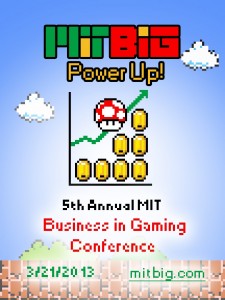Playing the Crowd at MIT BiG
-
-
slice.mit.edu
Filed Under
Recommended
 Veteran gamers and young professionals alike merged minds and avatars at the 5th annual Business in Gaming (BiG) Conference, held March 22 at the MIT Media Lab. Their goal: to figure out how video gaming can rebound as well as the economy has in recent months.
Veteran gamers and young professionals alike merged minds and avatars at the 5th annual Business in Gaming (BiG) Conference, held March 22 at the MIT Media Lab. Their goal: to figure out how video gaming can rebound as well as the economy has in recent months.More than 100 attendees heard from experts on topics like crowdfunding, big data, new distribution channels, and spectator entertainment in the $65-billion industry.
“The year 2012 was a very turbulent [one] for the gaming industry,” said Nicola Azevedo, co-president of the BiG Club at Sloan, which organized the conference. “Contracyclical to the economy, which recovered, the gaming industry shrunk.”
Though game sales may be down, spectating is up. Yes, video gaming is a spectator sport, now called “esports spectating.”
As panelists from Twitch.TV and Magic ProTour pointed out, there’s money to be made. Consider that a record 2.6 million gamers showed up online to watch Major League Gaming’s latest Winter Championships in early March. That’s almost as many fans as the Red Sox had in Fenway Park—in an entire season last year.
Throw some clickable ads in the way of esports spectators, or start charging admission for those millions of viewers, and you quickly understand how the industry could become more profitable.

BiG’s noontime Fireside Chat featured Ted Price, CEO and founder of Insomniac Games and Christopher Weaver SM ’85, founder of Bethesda Softworks and lecturer in MIT’s Comparative Media Studies program. You have Weaver to thank for the groundbreaking code behind John Madden Football and Wayne Gretzky Hockey.
Together, the two industry icons shared their strategies for success. Weaver credited Insomniac’s model of an inclusive corporate culture with helping it weather a recession while producing top-selling games like Resistance and Ratchet and Clank.
Weaver recalled his own frustrations with developing games in the '90s, when giants like Sega and Nintendo “controlled the destiny of anyone who wanted to make games on their platforms. They sat in the driver’s seat in every possible way,” he said.
Firms like Insomniac, Weaver added, broke out of that mold, created new gaming paradigms to complement their games’ futuristic first-person weaponry. Despite the stern M-for-Mature rating on their box and a down economy, games like World of Warcraft, Resistance, and God of War continue to earn hundreds of thousands of new fans each year.
Related: Registration is now open for a week-long course in August 2013 on “Game Development for Software Engineers,” hosted by MIT Professional Development and the MIT Game Lab, ranked in the top 10 colleges for Game Design by the Princeton Review for the past four years.







